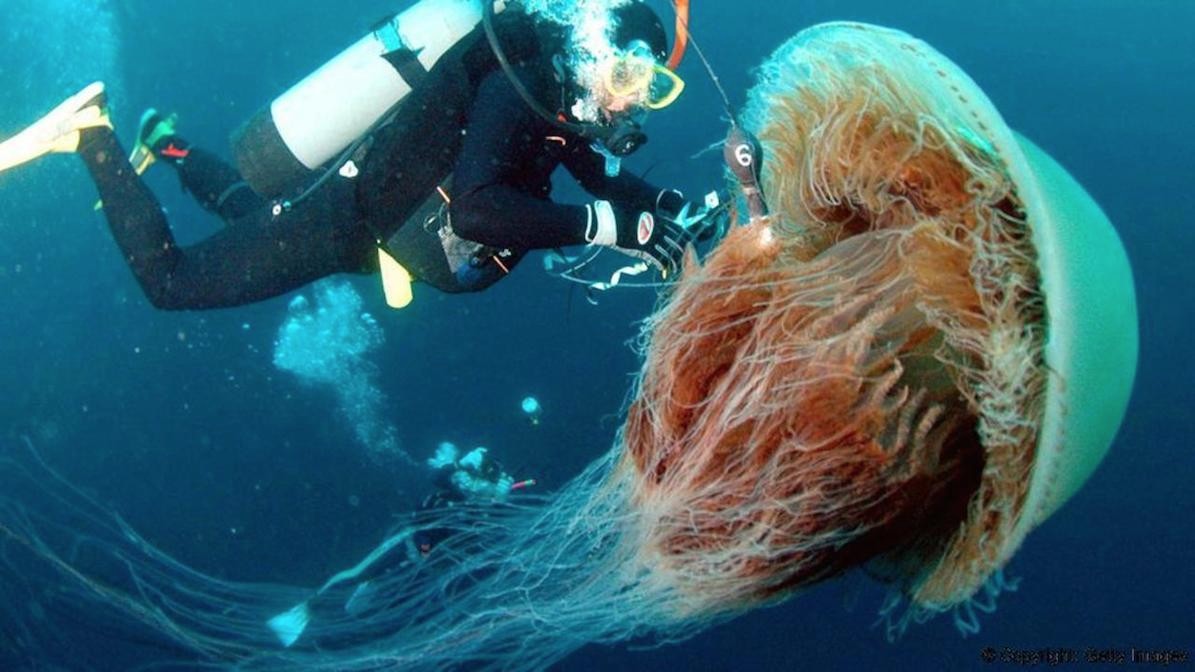 Jellyfish numbers have dramatically increased in many parts of the world and now scientists believe offshore wind farms and gas platforms may have a role in their proliferation. CREDIT: ALAMY
Jellyfish numbers have dramatically increased in many parts of the world and now scientists believe offshore wind farms and gas platforms may have a role in their proliferation. CREDIT: ALAMY
http://www.telegraph.co.uk | 12th aug, 2017
Nick Squires, rome
If you are noticing more jellyfish in the sea on your holiday this summer, the blame may lie just over the horizon.
Scientists have discovered that offshore wind farms and oil and gas platforms inadvertently provide an ideal habitat in which the gelatinous creatures can thrive.
Until now, the explosion in jellyfish numbers in oceans around the world has been largely blamed on over-fishing, which wipes out their natural predators, global warming and nutrient run-off.
But now it seems that man-made structures offer an enticing home for polyps – the tiny organisms which eventually grow into jellyfish.
“They preferably attach to downward-facing solid surfaces and since the availability of these is scarce in nature, they can be predominantly found on man-made structures,” the team of Slovenian and Portuguese scientists report.
The phenomenon is particularly pronounced in the Adriatic, where populations of a species called moon jellyfish have boomed in recent years.
Moon jellyfish – which do not have a strong enough sting to harm humans – were first detected in the Adriatic in the 1830s but their presence was a rarity. These days, huge blooms of the species appear every year.
<img class=”responsive article-body-image-image” src=”/content/dam/news/2016/11/18/PD3729864_Irukandji_trans_NvBQzQNjv4BqtkVbH_JhwhKpOG03so4XGNLPhd-V6CkgTVi3fP_K1c4.jpg?imwidth=480″ alt=”A few jellyfish are highly dangerous – even fatal – if they sting humans, including this irukandji jellyfish from Australia.”>
A few jellyfish are highly dangerous – even fatal – if they sting humans, including this irukandji jellyfish from Australia. CREDIT: AP
The researchers believe the explosion in numbers is closely related to the increased number of oil and gas platforms in the Adriatic – from just a handful in 1970 to around 150 now.
In a report published in Environmental Research Letters, they used computer simulations to recreate the dynamics of ocean currents and the life-cycle of moon jellyfish.
The results suggested a direct correlation between big jellyfish numbers and man-made structures such as energy platforms and wind farms.
The structures “enable the formation of new populations in formerly unpopulated open waters,” the scientists found after a five-year study. Scattered across the Adriatic in deep, open water, they enable isolated populations of jellies to find each other and breed.
The profusion of jellyfish was “an aspect that is usually overlooked when evaluating the ecological impact of existing and future wind farms, oil and gas platforms,” the scientists said.
Too many jellyfish in the sea not only signal the deterioration of marine ecosystems; they also clog the intake pipes of shore-based power stations and desalination plants, weigh down fishing nets and – in the case of some stinging species – present a danger to humans.
The research has implications for British waters, where hundreds of offshore turbines are under construction or planned.
Last year, for the first time, wind farms in the UK generated more electricity than coal-powered plants. Across Europe, the power-generating capacity of offshore wind installations more than doubled in three years, from 2012 to 2015.
“With the recent push towards renewable energy, the numbers (of wind farms) have skyrocketed, and that is just a fraction of what to expect in the future,” the scientists said.
With more wind farms and gas platforms planned, the boom in jellyfish numbers will only continue.
What is good for jellyfish is also good for other species of marine life, however.
A Dutch study found that offshore wind turbines provide a sanctuary in the open ocean for creatures such as crabs, mussels and anemones.
The 2011 study found that wind farms also had a much lower impact than previously thought on sea birds such as cormorants and gannets, contradicting fears that the whirring rotor blades of turbines could prove fatal to bird life.
“It turns out that a wind farm provides a new natural habitat for organisms living on the sea bed such as mussels, anemones and crabs, thereby contributing to increased biodiversity,” said Prof Han Lindeboom from Wageningen University.
“It provides an oasis of calm in a relatively busy coastal area.”
There could be unexpected benefits to the burgeoning numbers of jellyfish – scientists announced last month that they had invented jellyfish crisps, which they said were healthier than traditional, deep-fried potato crisps.
Researchers in Denmark discovered that by soaking jellyfish in alcohol and allowing it to evaporate, the gelatinous creatures turn into paper-thin, crunchy discs.















